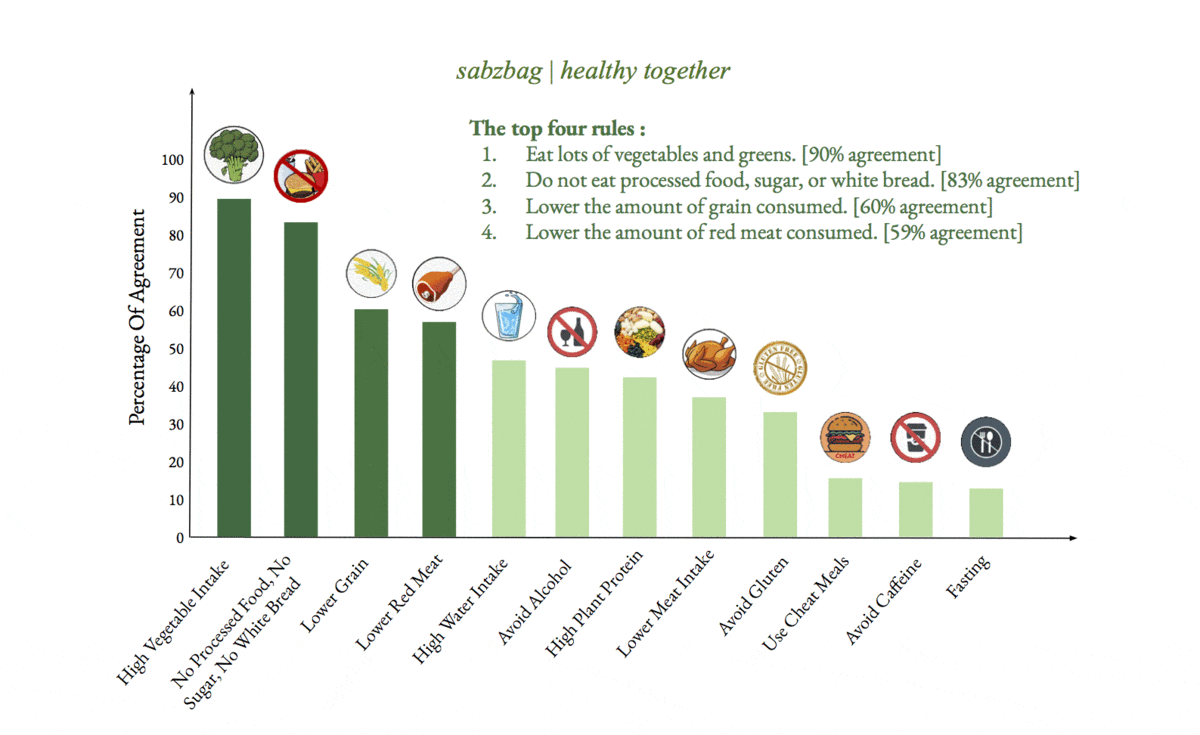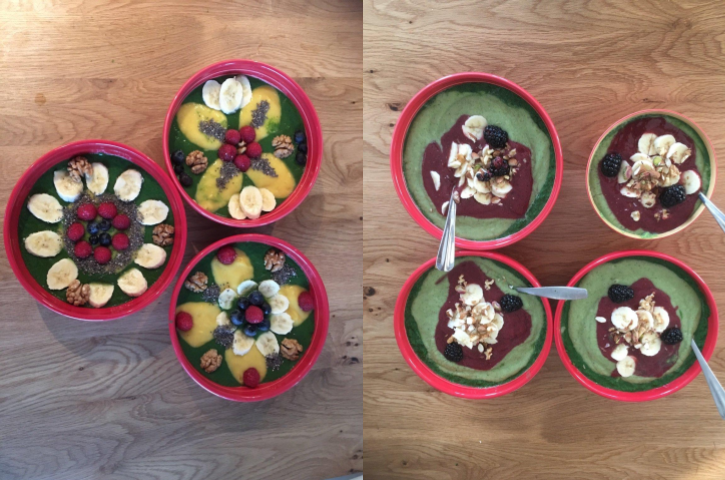4 Things 50 nutrition books and the EAT - Lancet meta-study actually agree on
|
|
|
|
 |
Figure 1: Percent (%) agreement among experts on nutrition advice. The height of a bar indicates what % of experts agreed on this topic. For example, there was near unanimous agreement (90%) on eating more greens and vegetables to achieve better health and that is shown on the extreme left with a dark green bar, whereas only 16% of the experts agree on using cheat meals as a part of a healthy nutrition plan, hence the height of the cheat meal bar is much lower and it is positioned on the right.
|
|
|
The Nutrition Wisdom of an Expert Crowd
We all have our favorite nutrition books, but often it is hard to know which expert to believe - one says coffee is great for you and the other says avoid it at all costs except on moonlit Tuesdays! What is a normal person with limited time to do?
Instead of relying on any single expert, we decided to trust the “wisdom of the expert crowd” and summarized around 50 of the best-selling books on nutrition (such as "The Blue Zones Solution", "The Paleo Diet", "The 4-Hour Body", "The China Study") and some landmark studies such as the one released by the EAT- Lancet commission - a meta-study of more than 350 academic articles on the topic of sustainable and healthy nutrition for our planet.
The simple principle behind the infographic is to emphasize the few practices that most of these experts and common sense agree strongly on and not get confused by the ongoing debates where there is little agreement. As the infographic illustrates, the top four useful practices are to eat plenty of vegetables, avoid eating any processed food, sugar or white bread, to lower the amount of grain consumed, and lower the consumption of red meat. In contrast, practices such as avoiding caffeine or dairy, or using cheat meals are not universally accepted as useful. Thus, for us normal people a better investment of energy would be to focus on what everybody agrees on. For more details check out our 0-1-2-3 summary. We will continue to learn so please share any book or paper that catches your attention and we will include it here.
|
|
|
|
|
|
The Smoothie Bowl Recipe
This tasty smoothie bowl helps you eat 3 servings of veggies for breakfast and tastes as good as it looks. It was the #1 hit in our fall Toronto Workhaus event. The recipe is included by public demand over Apurv's patent pending protests. |
|
 |
Recipe:
- Take 300 g of spinach + about 400g of water + 15 g of walnuts + a thumb size chunk of ginger + 1 scoop vegan protein (optional) and blend them for about 3 minutes until it is well mixed.
- Pour about half of the mix into the bowl.
- Add 200g of frozen blueberries (or your favourite fruit- mango, raspberries etc.) and 50 -100 g of water or coconut milk (depending on the taste or consistency you want) and blend again.
- Pour the resulting blend on top of the previous blend. It creates a cool effect and provides a different taste and texture within the smoothie bowl.
- Garnish with chia seeds, cashews and goji berries.
With this basic proportions of greens, nuts, and fruits in place you can tweak the recipe to make it your own. Experiment, have fun, and tell us about it! |
|
|
|
|
Cheat Your Tongue 101
Wouldn't it be the ultimate superpower to eat tasty food during holidays and not put on those couple of pounds? Check out this video for 6 quick hacks to cheat your tongue and delight your body! |
 |
|
|
|
|
Community Corner
Community support improves health
So why bother with a communal pursuit of health? Intuitively because friends make it easy and fun to do tough things: even in our own little community we find that chatter and health performance seem to go hand in hand. For us, it is not clear yet if it is causal, but it turns out the extraordinary effectiveness of social incentives for better health is a phenomenon well known in academia.
"On average, it turned out that the social network incentive scheme worked almost four times more efficiently than a traditional individual-incentive market approach (italics ours). For the buddies who had the most interactions with their assigned target, the social network incentive worked almost eight times better than the standard market approach. And better yet, it stuck. People who received social network incentives maintained their high levels of activity even after the incentives disappeared. These small but focused social network incentives generated engagement around new, healthier habits of behavior by creating social pressure for behavior change in the community." Social physics : how good ideas spread the lessons from a new science, pp 94.
|
|
|
